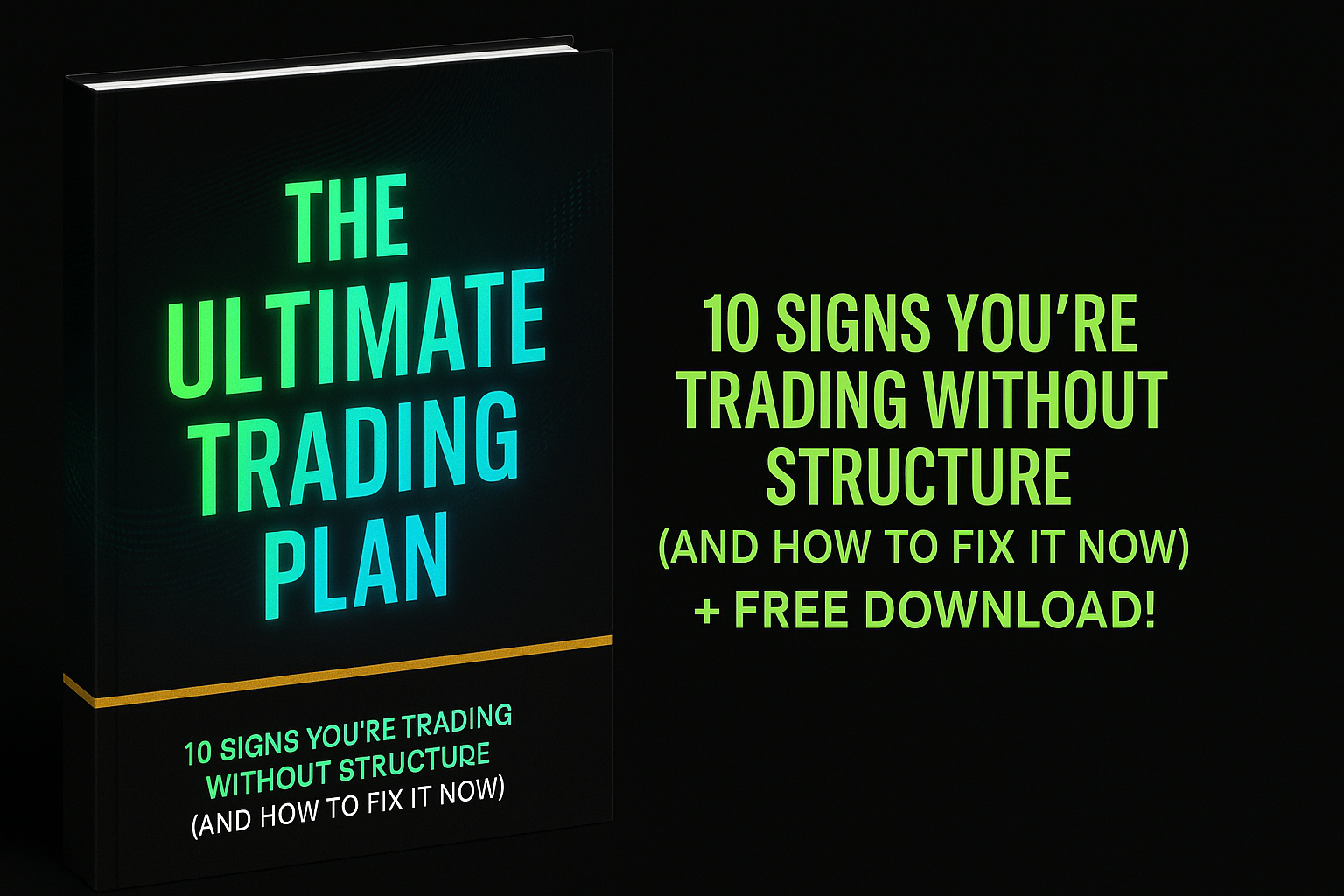Your basket is currently empty!
Read Time: 7 minutes
The Ultimate Trading Plan Journal: Free Download


Want to fix these 10 signs immediately? We’ve created a complete, fill-in-the-blank Trading Plan Journal that walks you through building your own structured trading system step by step.
Inside you’ll get:
Goal-setting worksheets
Risk management calculators
Entry & exit rule templates
Daily/weekly review checklists
Psychology & mindset trackers
Download it FREE right now and start trading with structure today
Key Takeaways
- Trading without structure leads to inconsistent results and unnecessary losses
- Random entries, emotional exits, and inconsistent risk management are the biggest red flags
- Professional traders follow predetermined rules for every aspect of their trading
- Structure can be learned and implemented through systematic rules and regular review
- Fixing even one of these issues can dramatically improve your trading performance
Let’s be real for a second.
You’ve probably had those trading days where everything feels… off. You’re jumping from chart to chart, second-guessing every decision, and wondering why other traders seem to have it all figured out while you’re stuck in this cycle.
Here’s the truth: they have something you might be missing. Structure.
Why Structure Matters in Trading
Think of trading without structure like driving cross-country without a map or GPS. Sure, you might eventually get somewhere, but you’ll waste a ton of gas, take wrong turns, and probably end up frustrated.
We’ve seen this pattern repeat itself hundreds of times with traders at all levels. The good news? Once you recognize these signs, you can actually do something about them.
So let’s dive into the 10 telltale signs that you’re trading without structure and more importantly, what you can do to fix it.
1. Random Entries: No Clear Buy Point
You see a chart moving and think, “This looks good!” So you jump in.
But when someone asks why you entered at that specific moment, you don’t have a solid answer. Maybe the candle looked bullish. Maybe you had a gut feeling.
The reality: Professional traders enter based on predetermined criteria specific price levels, indicator confirmations, or pattern completions. If you can’t explain your entry in one clear sentence, it’s probably random.
The fix: Write down your exact entry rules before you take another trade. What needs to happen before you click that buy button?
2. Inconsistent Risk: Different Size Each Trade
One trade you risk $50. The next trade you risk $200. Then $100. Then “just a small position” that you don’t even calculate.
This is one of the fastest ways to blow up an account, and we see it all the time.
The reality: Position sizing should be systematic, not emotional. Your risk per trade should be a consistent percentage of your account whether that’s 1%, 2%, or whatever your risk tolerance allows.
The fix: Calculate your position size before every trade based on your stop loss and account size. No exceptions.
Need Help Building Your Trading Structure?
Look, we get it. Building a solid trading system from scratch is tough, especially when you’re learning by trial and error.
That’s exactly why we created our trading coaching program to help traders like you develop a structured approach that actually works. We’ll work with you one-on-one to build your personalized trading plan, refine your strategy, and hold you accountable.


And if you prefer a more hands-off approach, our automated trading robots handle the structure for you. They follow the rules every single time no emotions, no second-guessing, just consistent execution.


Want to learn more? Check out our programs at ConnectMyCurrency.com.
3. Emotional Exits: Selling From Fear
Your trade is up 2%. Then it drops to 1.5%. Panic sets in.
“What if it reverses? What if I lose everything?” So you sell only to watch it rally to your original target five minutes later.
The reality: Fear-based exits destroy profit potential. You’re letting your emotions override your strategy, which means you have no strategy at all.
The fix: Set your profit targets and stop losses when you enter the trade then walk away. Let the market do its thing.
4. No Watchlist: Every Day Starts From Zero
Monday morning. You open your trading platform and think, “So… what should I trade today?”
You start scanning hundreds of charts, hoping something catches your eye. By the time you find something, the best opportunities have already moved.
The reality: Professional traders prepare their watchlists in advance. They know exactly which assets they’re monitoring and what conditions need to be met.
The fix: Spend Sunday evening or early morning creating your watchlist for the week. Use scanners, technical criteria, or fundamental analysis just have a plan.
5. Ignoring Market Trend: Fighting the Tide
The market is clearly trending down, but you keep looking for long positions because “it has to bounce eventually.”
Spoiler alert: it doesn’t have to do anything.
The reality: Trading against the trend is like swimming against a strong current it’s exhausting and usually unsuccessful. The trend is your friend, as cliché as it sounds.
The fix: Identify the overall market trend first, then look for trades that align with it. If you’re not sure how to identify trends, check out our guide on reading market direction.
6. Chasing Price: Entering After Big Moves
You see a stock rocket up 5% and think, “I need to get in on this!”
So you buy at the top, only to watch it immediately reverse. Now you’re stuck in a losing position, hoping for another leg up that might never come.
The reality: FOMO (fear of missing out) is not a trading strategy. Chasing price almost always leads to buying high and selling low.
The fix: Wait for pullbacks or wait for the next setup. There’s always another trade.
7. Missing Stops: Hoping Instead of Acting
Your stop loss hits, but instead of exiting, you think, “Let me give it a little more room. It might come back.”
Then it drops further. And further. Now a small loss has become a devastating one.
The reality: Stop losses exist for a reason to protect your capital. Ignoring them is like removing the brakes from your car and hoping you won’t need them.
The fix: Treat your stop loss as non-negotiable. The moment it hits, you’re out. No excuses.
Want More Trading Insights?
If you’re enjoying this post, you’ll love our other content on building profitable trading habits.
Check out these articles:
- How to Create a Winning Trading Plan
- Risk Management Strategies Every Trader Needs
- The Psychology Behind Successful Trading
And don’t forget to Subscribe to our newsletter for weekly trading tips, market insights, and exclusive access to our trading community. Join hundreds of traders who are leveling up their game every week.
8. Over-Screening: Searching Instead of Executing
You spend hours analyzing charts, reading news, watching YouTube videos, and scrolling through trading forums.
But when it’s time to actually place a trade? Paralysis. You’ve over-analyzed yourself into inaction.
The reality: Analysis is important, but at some point, you need to execute. Overthinking kills opportunities.
The fix: Set a time limit for your analysis. Once your criteria are met, take the trade. Trust your system.
9. Strategy Hopping: New “Edge” Each Week
Last week you were trading breakouts. This week you’re trying scalping. Next week you heard about some indicator that’s “95% accurate.”
Sound familiar?
The reality: Constantly switching strategies means you never master any of them. Every strategy needs time to prove itself usually several months, not several days.
The fix: Pick one strategy and stick with it for at least 100 trades. Track your results. Then decide if you need to adjust.
10. No Review: Mistakes Repeat Endlessly
You take trades, win some, lose some, and then… nothing. No reflection. No analysis. No improvement.
So next week, you make the same mistakes. And the week after that. And the cycle continues.
The reality: The best traders are obsessive about reviewing their trades. They keep journals, track metrics, and constantly look for patterns in their behavior.
The fix: Spend 15 minutes at the end of each trading day reviewing your trades. What went well? What didn’t? What will you do differently tomorrow?
The Bottom Line
Trading without structure isn’t just inefficient it’s expensive.
Every random entry, every emotional exit, and every missed stop costs you money. But here’s the good news: structure can be learned. It can be built. And it can completely transform your trading results.
Start by addressing just one of these signs this week. Pick the one that resonates most with you and create a rule around it. Write it down. Follow it religiously.
Then next week, tackle another one.
Before you know it, you’ll have a complete trading system and your results will start reflecting it.
Ending: Lessons Learned
Structure is the foundation of profitable trading. Without it, you’re essentially gambling rather than trading systematically.
Start small, but start now. You don’t need to fix everything at once. Pick one area whether it’s creating a watchlist, calculating consistent position sizes, or keeping a trading journal—and make it a non-negotiable part of your routine.
Discipline beats intelligence. The smartest trader with no discipline will lose to an average trader with iron-clad rules every single time.
Your trading plan should answer these questions:
- When do I enter? (specific criteria)
- How much do I risk? (consistent percentage)
- Where do I exit? (both profit targets and stop losses)
- What do I trade? (predetermined watchlist)
- How do I improve? (regular review process)
Remember: Every professional trader started where you are now. The difference is they committed to building structure, one rule at a time. Your future trading success depends on the systems you build today.
Now It’s Your Turn
Which of these 10 signs hit closest to home for you? Are you dealing with emotional exits? Chasing price? Strategy hopping?
Drop a comment below and let us know. We read every single one, and we love hearing about your trading journey. Plus, your experience might help another trader who’s struggling with the same thing.
Let’s build better trading habits together.
DISCLOSURE
Trading foreign exchange, stocks, commodities, and other financial instruments involves substantial risk and is not suitable for all investors. Past performance is not indicative of future results. You could lose some or all of your invested capital; therefore, you should not speculate with capital that you cannot afford to lose. The content on this blog is for educational purposes only and should not be considered financial advice. Always consult with a qualified financial advisor before making investment decisions. We may receive compensation for products or services mentioned on this site.

0 responses to “10 Signs You’re Trading Without Structure (And How to Fix It Now)”